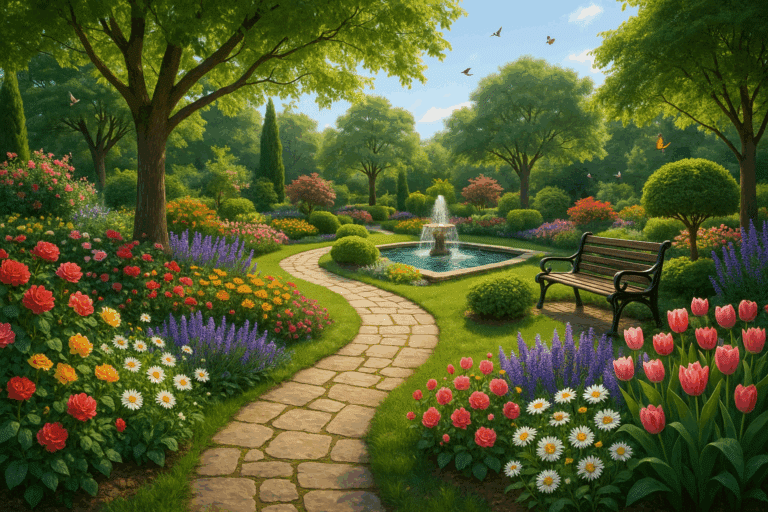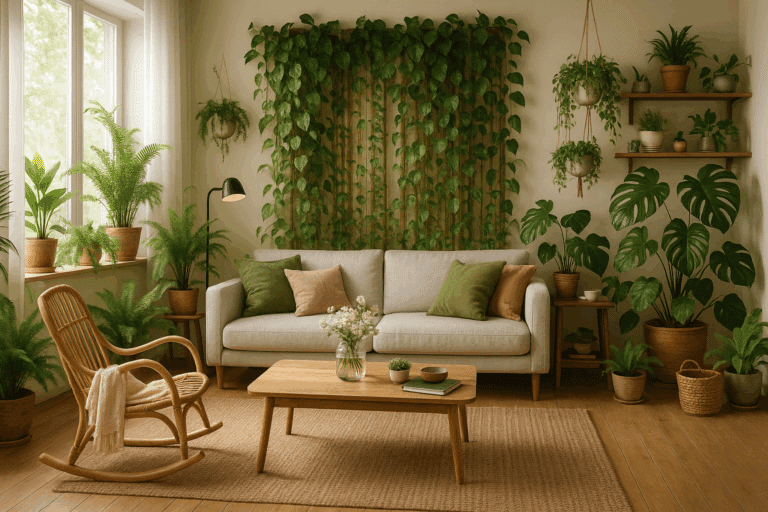Welcome to the miniature world of terrariums! 🌱 These tiny ecosystems, brimming with verdant flora, allow us to create, sustain, and enjoy a bit of nature within the confines of our own homes.
Embracing a blend of art, science, and a dash of imagination, terrariums are not merely decorative items; they are microcosms of the natural world. A terrarium is more than just a glass container filled with plants; it is a living, breathing environment that brings the outdoors indoors, making it an ideal choice for urban dwellers and nature enthusiasts alike.
With their unique aesthetic and minimal maintenance, terrariums have seen a resurgence in popularity in recent years, becoming a favorite for interior decorators, hobbyists, and plant lovers. Whether you’re a veteran green thumb or a gardening novice, there’s something inherently magical about these miniature green worlds that captivates the imagination. 🌿
The journey into this article will delve into the enchanting world of terrariums, exploring their history, different types, and essential components. Along the way, we’ll also unlock the key steps to creating and caring for your own tiny terrariums, and the myriad ways they can add a touch of green to your living space.
Our first stop will be a trip down memory lane as we look back at the origins of terrariums, their evolution over the years, and their enduring appeal in today’s world. From their accidental invention by a 19th-century botanist to their place in the modern urban jungle, you’ll learn about the fascinating history behind these tiny ecosystems.
Next, we’ll explore the different types of terrariums – closed, open, and semi-closed. Each has its own unique characteristics, benefits, and challenges. We’ll delve into the details of what makes each type special, and how to choose the right one for your space and lifestyle.
Creating a terrarium is akin to creating a work of art. Each element, from the container to the plants to the soil, plays a vital role in the success of your tiny ecosystem. We’ll dissect the anatomy of a terrarium, guiding you through the selection of each component, and the role they play in your miniature green world.
Of course, what’s a terrarium without its star residents – the plants? 🌵 We’ll take a close look at the best plants for terrariums, considering factors like size, growth rate, light and moisture requirements, and compatibility with other plants.
Lastly, we’ll delve into the nuts and bolts of terrarium maintenance. Keeping your mini ecosystem thriving requires a little care and attention, but don’t worry, we’ll arm you with all the tips and tricks to keep your terrarium lush and healthy.
Whether you’re an experienced gardener or just a curious soul yearning for a slice of nature, this comprehensive guide will serve as a roadmap, leading you through the exciting journey of creating and caring for your own miniature green world. So, are you ready to let the magic of tiny terrariums create a big impact in your life? Let’s embark on this green journey!
Exploring the Fascinating Miniature World of Terrariums
Imagine having an entire ecosystem nestled on your desk or coffee table, teeming with life, and providing a green oasis in your living space. That’s exactly what terrariums offer – a mesmerizing miniature world that brings nature indoors in the most whimsical way. If you’re interested in creating your own tiny terrarium, or simply curious about these microcosms of greenery, you’ve come to the right place. In this article, we delve deep into the world of terrariums, exploring their history, types, care, and more.
The concept of terrariums dates back to Victorian times, when Dr. Nathaniel Bagshaw Ward discovered that plants could thrive in sealed glass cases. This discovery led to the creation of the ‘Wardian case’, the precursor to modern terrariums. Today, these miniature gardens continue to enchant plant enthusiasts and interior designers alike, combining nature, science, and art in a glass container.
But what exactly is a terrarium, you might wonder? In essence, a terrarium is a small, enclosed environment for certain plants and sometimes small animals. It’s typically a glass container, although other materials like plastic can also be used. A terrarium replicates a natural environment on a much smaller scale, complete with a mini landscape.
Types of Terrariums: Comparing Open and Closed Systems
| Type of Terrarium | Characteristics | Suitable Plants |
|---|---|---|
| Open Terrarium | Allows air circulation and lower humidity. Needs regular watering. | Succulents, cacti, and air plants. |
| Closed Terrarium | Creates a high humidity environment. Needs less watering due to moisture recycling. | Ferns, mosses, and other humidity-loving plants. |
Choosing between an open and closed terrarium mainly depends on the types of plants you wish to grow. Open terrariums are ideal for plants that prefer a dry environment, like succulents and cacti. On the other hand, closed terrariums, with their self-sustaining humid environment, are perfect for moisture-loving plants like ferns and mosses.
For a visual explanation of these two types of terrariums, check out the video “Terrariums: A Miniature Ecosystem in a Bottle” by SciShow. They do an excellent job of detailing the differences between open and closed systems, as well as the science behind how terrariums work.
Creating Your Own Terrarium: A Step-by-Step Guide
Creating a terrarium is easier than you might think. It can be a fun and rewarding DIY project, and the end result is a beautiful addition to your indoor space. Here’s a step-by-step guide to creating your own terrarium:
- Select your container: This can be any clear glass or plastic container. You can get creative here – think mason jars, fish tanks, or even light bulbs!
- Layer the bottom: Start by adding a layer of pebbles or stones. This serves as drainage for excess water.
- Add activated charcoal: This helps prevent bacteria and fungi growth, keeping your terrarium healthy.
- Put in potting soil: Choose a potting mix suitable for your selected plants.
- Plant your plants: Arrange your plants in the soil, taking care to space them out properly.
- Add decorations: This is optional, but adding small figurines or stones can enhance the visual appeal of your terrarium.
- Water your terrarium: Give your new mini garden a good watering, but be careful not to overwater.
Caring for Your Terrarium: Tips for Success
Once you’ve set up your terrarium, it’s important to care for it properly to ensure its longevity. Here are some tips for terrarium care:
- Light: Terrariums need plenty of indirect light. Avoid placing them in direct sunlight, as this can cause them to overheat.
- Watering: Water sparingly. For closed terrariums, the moisture will recycle itself. Open terrariums will need more frequent watering, but be careful not to overwater.
- Pruning: Keep your terrarium looking neat and healthy by pruning any overgrown or dead plant material.
- Cleaning: Keep the glass clean for optimal light penetration and aesthetics.
Remember, every terrarium is unique and will require slightly different care depending on the plants and setup. However, with the right care and attention, your terrarium can provide a beautiful green addition to your indoor space for years to come.
To see terrarium care in action, I recommend watching “How to Care for Your Terrarium” by Epic Gardening. This video provides a comprehensive guide to terrarium maintenance, with tips on everything from watering to light requirements.
The Impact of Terrariums: More Than Just Decor
While terrariums are undeniably charming and make for great decor, their impact extends far beyond aesthetics. Terrariums offer numerous benefits, from improving indoor air quality to providing therapeutic value.
Plants are known to improve air quality by absorbing toxins, producing oxygen, and increasing humidity. This can lead to better health, improved mood, and increased productivity. Additionally, the act of caring for plants has been shown to have therapeutic value, reducing stress and promoting relaxation.
But perhaps the most profound impact of terrariums is their ability to inspire curiosity and a deeper appreciation for nature. By bringing the beauty and complexity of ecosystems into our homes, terrariums invite us to explore, learn, and engage with the natural world on a micro scale.
Discover the Magic of Terrariums Today
Ready to embark on your own terrarium adventure? There’s a whole world of tiny green landscapes waiting to be explored. Whether you’re a seasoned plant enthusiast or a total beginner, creating a terrarium can be a rewarding and fun project. So why not start today? Watch the video, gather your materials, and discover the magic of terrariums for yourself.
Happy terrarium making!

Conclusion
In conclusion, the exploration of the topics we’ve discussed is undeniably important for anyone in the fields of IT and engineering. From understanding the core principles of software engineering, to unraveling the complexities of modern technologies such as artificial intelligence and blockchain, these are concepts that lie at the very heart of today’s digital world.
By gaining a solid grasp of these subjects, you not only empower yourself with knowledge, but you also equip yourself with the skills needed to navigate the ever-changing technological landscape. These, combined with the valuable insights we’ve shared on the best practices in software development, and the role of data security in today’s interconnected world, serve as a solid foundation for anyone looking to thrive in these fields.
One of the key takeaways from our discussion is the significance of constant learning and adaptation. With the relentless pace at which technology evolves, it’s crucial to keep oneself updated with the latest trends and developments. 📚
The breadth and depth of topics we’ve covered may seem overwhelming, but the beauty of it lies in the process of learning itself. Every piece of information, every new concept learned, is a step towards becoming more competent and proficient in your field. 💡
Remember, every expert was once a beginner. As Steve Jobs once said, “Stay hungry, stay foolish”. The hunger for knowledge and the willingness to learn are what separate the good from the great.
As you continue to explore these topics, I encourage you to share your thoughts and experiences. The comment section below is a great place for you to ask questions, share insights, or engage in discussions with others who are also passionate about these topics. Remember, the more we share, the more we learn.
If you’ve found this article helpful, feel free to share it with your friends and colleagues. The more we spread knowledge, the more we contribute to a smarter, more informed world. 🌐
In closing, I’d like to express my gratitude for taking the time to read this article. I hope it has provided you with a deeper understanding of the discussed topics and sparked a desire to learn more. As always, I’m here to assist and guide you in your journey.
Until next time, keep exploring, keep learning, and most importantly, keep growing. 🚀
If you wish to delve deeper into the subjects we discussed, here are a few reputable sources to get you started:
– [MIT OpenCourseWare: Introduction to Computer Science and Programming](https://ocw.mit.edu/courses/electrical-engineering-and-computer-science/6-0001-introduction-to-computer-science-and-programming-in-python-fall-2016/)
– [Harvard’s CS50: Introduction to Computer Science](https://cs50.harvard.edu/x/2020/)
– [Khan Academy: Computer Programming](https://www.khanacademy.org/computing/computer-programming)
– [Stanford University: Artificial Intelligence](https://online.stanford.edu/courses/cs221-artificial-intelligence-principles-and-techniques)
– [University of California Berkeley: Blockchain Fundamentals](https://blockchain.berkeley.edu/courses/)
These are just a few of the myriad of resources available out there. Remember, the world of technology is vast and expansive. There’s always something new to learn. Happy exploring!
References:
[1] MIT OpenCourseWare
[2] Harvard’s CS50
[3] Khan Academy
[4] Stanford University
[5] University of California Berkeley



